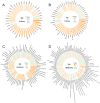Circulating mediators linking cardiometabolic diseases to HFpEF: a mediation Mendelian randomization analysis
- PMID: 40355922
- PMCID: PMC12070650
- DOI: 10.1186/s12933-025-02738-0
Circulating mediators linking cardiometabolic diseases to HFpEF: a mediation Mendelian randomization analysis
Abstract
Background: Heart failure with preserved ejection fraction (HFpEF) is an increasingly prevalent clinical syndrome with high morbidity and mortality. Although HFpEF frequently coexists with cardiometabolic diseases, the causal mechanisms and potential mediators remain poorly understood.
Objectives: This study aimed to identify cardiometabolic risk factors specifically driving HFpEF and to determine their underlying circulating mediators.
Methods: We used two-sample Mendelian Randomization (MR) to analyze the effects of obesity, Type 2 diabetes, hypertension, chronic kidney disease (CKD), and dyslipidemia on HFpEF and heart failure with reduced ejection fraction (HFrEF) in large European-ancestry GWAS datasets. We then performed mediation MR to identify plasma proteins and metabolites that mediate the transition from each cardiometabolic disease to HFpEF, respectively. We applied multivariable MR to assess the impact of risk confounding on the results. Bioinformatic analyses were conducted to delineate mechanisms.
Results: Cardiometabolic diseases had heterogeneous effects on HFpEF and HFrEF. Obesity and type 2 diabetes showed adjusted causal effects with HFpEF, hypertension showed potential relevance to HFpEF, whereas dyslipidemia and CKD did not. MR analysis identified 5 proteins that mediate obesity to HFpEF; 5 proteins that mediate type 2 diabetes to HFpEF. Further mediation MR analysis of obesity and T2D on HFrEF revealed heterogeneity in circulating mediators between metabolic HFpEF and HFrEF. Comprehensive bioinformatics analyses showed that IL1R1, together with other proteins such as TP53 and FGF19, orchestrates the inflammatory and fibrotic processes underlying HFpEF.
Conclusions: These findings suggest that metabolic HFpEF has distinct etiological features compared with HFrEF and is driven by complex, condition-specific mediators. IL1R1 mediates HFpEF in multiple metabolic risk states, suggesting a potential therapeutic target. Further translational studies are warranted to evaluate anti-inflammatory strategies targeting IL1R1 in HFpEF.
Keywords: Cardiometabolic diseases; Circulating mediators; HFpEF; IL1R1; Type 2 diabetes.
© 2025. The Author(s).
Conflict of interest statement
Declarations. Ethics approval and consent to participate: Summary-level GWAS statistics used in this study is publicly available and no specific ethical approval was required. Consent for publication: Not applicable. Competing interests: The authors declare no competing interests.
Figures






References
-
- Campbell P, Rutten FH, Lee MM, Hawkins NM, Petrie MC. Heart failure with preserved ejection fraction: everything the clinician needs to know. Lancet. 2024;403(10431):1083–92. - PubMed
-
- Capone F, Vettor R, Schiattarella GG. Cardiometabolic HFpEF: NASH of the heart. Circulation. 2023;147(6):451–3. - PubMed
-
- Zhang L, Cunningham JW, Claggett BL, Jacob J, Mendelson MM, Serrano-Fernandez P, Kaiser S, Yates DP, Healey M, Chen CW, et al. Aptamer proteomics for biomarker discovery in heart failure with reduced ejection fraction. Circulation. 2022;146(18):1411–4. - PubMed
-
- Jhund PS, Kondo T, Butt JH, Docherty KF, Claggett BL, Desai AS, Vaduganathan M, Gasparyan SB, Bengtsson O, Lindholm D, et al. Dapagliflozin across the range of ejection fraction in patients with heart failure: a patient-level, pooled meta-analysis of DAPA-HF and DELIVER. Nat Med. 2022;28(9):1956–64. - PMC - PubMed
MeSH terms
Substances
Grants and funding
LinkOut - more resources
Full Text Sources
Medical
Research Materials
Miscellaneous

